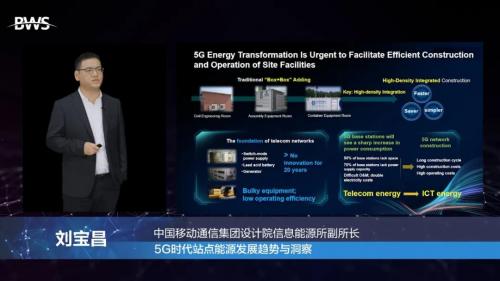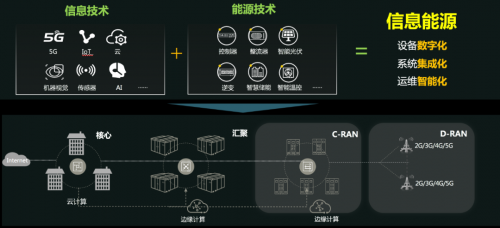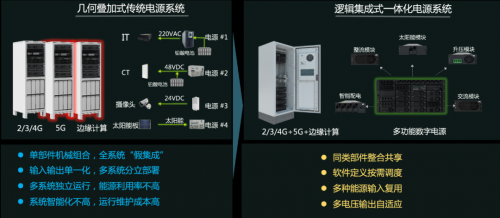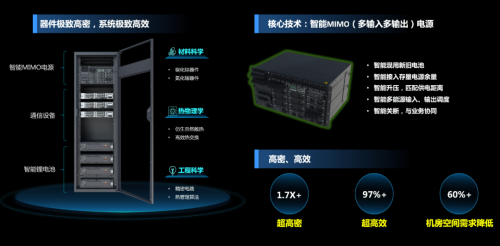
In the 5G era, the power supply problem needs to be solved urgently
• 2/3/4/5G superimposed construction makes it difficult to rebuild the equipment room
For the construction of 5G macro stations, the main sites are co-located on the original sites. The superposition of 2/3/4/5G brings problems such as insufficient mains power, insufficient DC power distribution, insufficient battery backup power, and insufficient temperature control capacity, resulting in 90 More than% of the existing power supplies need to be expanded and reconstructed, which brings challenges such as a large amount of reconstruction projects, high costs, and long cycles. At the same time, the newly added cabinets and batteries are limited by the space and load-bearing capacity of the computer room, and there are also difficulties in reconstruction.
• Massive small and micro sites have complex scenarios, and the power supply quality is difficult to guarantee
In the 5G era, small and micro sites that are mainly installed on poles and wall mounts will explode. They will be deployed in complex scenes such as streets, office buildings, urban villages, subways, and tunnels. The quality of power supply in these scenarios is difficult to guarantee and often Power supply is interrupted due to lightning strikes, line switching, pressure fluctuations, impact loads, etc.

This article comes from the network excellent mercenary
From 2G to 4G, every time we walk into the computer room, we can see familiar power cabinets, lead-acid battery packs and other equipment, which are the cornerstone of the communication network-the communication power system.
In the past few decades, mobile communication technology has been continuously driving social progress at the rate of upgrading and updating of the “10-year G”. With the rapid development of communication technology, communication equipment has become more integrated and miniaturized, and the space occupied by the computer room is getting smaller and smaller.
However, as the cornerstone of the power supply of communication equipment, the power system has not undergone essential changes for more than 20 years-the traditional discrete architecture deployment of switching power supply and storage battery is still used, the computer room occupies a large space, multiple systems operate independently, and the power supply efficiency Not high, low level of intelligence, high maintenance cost.

At the same time, with the transition from “communication station” to “social station”, a large number of small and micro sites will be integrated with a wide range of social resources, which requires the power system of small and micro sites to support multiple power supply inputs and integrated support Multi-voltage output provides differentiated power supply for base station equipment, cameras, sensor equipment and other equipment.
• Diversified business development and new requirements for power supply
In order to provide a variety of applications to all walks of life, the 5G era network will be integrated with cloud, edge computing, big data and other technologies to form a cloud-pipe-side integrated network architecture. The computing power and applications of the cloud and the user plane functions of the core network will sink to sites, access, convergence, and core computer rooms. The coexistence of IT and CT equipment will cause the demand for site energy facilities to double, and the power supply requirements for IT and CT equipment Differences will also lead to multiple power supply systems, which brings challenges such as difficulty in upgrading and transformation and limited space in the computer room.
At the same time, vertical industry applications, such as autonomous driving and industrial Internet, require a consistent deterministic SLA guarantee, which places very high requirements on the reliability of power supply in the 5G era.
Liu Baochang said that in the 5G era, there are more and more site services, higher density of sites, and stronger site bearers, which will magnify, superimpose, and double the demand for site energy infrastructure. If traditional power solutions are adopted, 5G construction will face Insufficient computer room space, insufficient power supply capacity, insufficient operation and maintenance capabilities, etc., bring pain points such as long 5G construction cycles, high construction costs, and high operating costs. Therefore, energy transformation in the 5G era is imperative, and a transformation from communication energy to information energy is required , To help 5G network construction and operation.
The 5G era calls for the transformation of communication power to information energy
Liu Baochang pointed out that information energy refers to the in-depth integration of information and communication technology (bit) and power supply technology (watts) to realize the digitization, integration and intelligence of energy conversion, storage and control, so as to flexibly satisfy the communication network from the core network (data center). ), the energy supply requirements of the entire scene, such as the aggregation layer and the site, and build a reliable, efficient and intelligent energy network.
Specifically, the first is to realize the digitization of energy equipment based on information energy technology, continuously promote the upgrading of energy products, and flexibly match the network evolution.
In order to flexibly meet the power supply requirements of various scenarios, energy digitization can realize software-definable power supply functions, and realize software-definable multi-input and output power products. At the same time, in terms of product structure, it is recommended to move from components to functional modules to full modularization of the system. According to network requirements, the system can be configured flexibly and dynamically. In terms of energy system composition design, it is recommended to transform the independent design of each subsystem of the traditional scheme to the integration The integrated design of the station system has shifted from focusing on component performance to focusing on overall station performance, using more intelligent technologies to accelerate the large-scale application of green energy.
Secondly, change from “geometric superimposed traditional power supply system” to “logic integrated integrated power supply system” to achieve system integration.
Traditional energy infrastructure construction is based on passive response and adopts geometric superposition deployment. There are disadvantages such as single-component mechanical combination, single input and output, independent operation of multiple systems, and low system intelligence.
Single-component mechanical combination, that is, simply install a set of power supply and several sets of batteries in a cabinet, without real system integration; single input and output, that is, a set of power supply system corresponds to one type of ICT equipment. This leads to the discrete deployment of multiple systems and the independent operation of multiple systems, resulting in configuration waste and low energy utilization. In addition, in the existing entire communication network, only the power supply system is non-digital and non-intelligent, mainly relying on manual operation. Station operation and maintenance, which will lead to continuous increase in operation and maintenance costs.
The logic integrated integrated power system is based on the information energy technology of the deep integration of bits and watts, which can realize the integration and sharing of similar components, software-defined on-demand scheduling, multiple energy input multiplexing, and multi-voltage output adaptation.
Furthermore, move towards intelligent operation and maintenance and improve operation efficiency.
Currently, site energy facility monitoring mainly relies on the traditional dynamic environment system, which is actually “monitoring but not control”. 80% of site operation and maintenance rely on manual site inspections, locating problems and handling faults, resulting in low operation and maintenance efficiency. The cost is high; at the same time, due to the lack of efficient energy management and precise allocation, it also causes a waste of resources. Entering the 5G era, the number of sites has doubled, and if the traditional method continues, the total operating costs will rise sharply. Therefore, in the 5G era, intelligent means must be used to realize intelligent operation of the site to reduce operating costs.
Intelligent operation and maintenance is to combine new-generation information technologies such as artificial intelligence, Internet of Things, and cloud computing to build an intelligent power supply operation system from platform to system, system to equipment, and realize digital management and control of energy facilities, intelligent collaboration of energy and business, Intelligent inspection, operation and maintenance, and at the same time allow the site energy facilities to have the characteristics of self-learning, self-diagnosis, self-maintenance, and self-renewal, and promote the application of site energy into the era of intelligence.
Innovative integrated energy cabinet to help 5G construction be faster, more economical and simpler
The future has come, the change has come. Aiming at the pain points of power supply and construction of base stations in the 5G era, China Mobile Design Institute has adopted digital sensing, control, processing and other technologies to completely define the communication power supply, independently researched and developed an integrated energy cabinet product, and realized multiple energy inputs and multiple outputs Intelligent applications can solve the problems of computer room space and insufficient power supply capacity.
The core technology of this product is intelligent MIMO (multiple input multiple output) power supply, using small-volume devices such as silicon carbide, gallium nitride, bionic natural heat dissipation technology and digital precision circuit engineering technology, realizing digital energy technology and intelligently dispatching multiple energy sources Input/output, smart mixing of new and old batteries, smart access to the remaining power supply, smart boost to match the power supply distance, and smart shutdown in collaboration with the business.
Liu Baochang introduced that the energy density of the product has increased by 1.7 times, and the rectification efficiency is as high as 97%, achieving high density and high efficiency; an integrated energy cabinet can accommodate 2G/4G/5G communication equipment, power equipment and battery equipment, and realize separation from multiple cabinets The change from the layout to the integrated layout of a single cabinet reduces the space requirement of the computer room by about 60%, which greatly reduces the difficulty of site selection and construction costs.
At present, the integrated energy cabinet has achieved large-scale applications in the construction of China Mobile’s 5G network, realizing the “three exemptions” of base station energy transformation in the 5G era, that is, no mains transformation, no power transformation, and no battery replacement, thus allowing 5G construction Save time, cost, and electricity. Take the transformation of a typical C-RAN computer room as an example. The original 11 cabinets can be integrated into 3 cabinets by using an integrated energy cabinet. A set of intelligent MIMO power supplies can replace three sets of traditional switching power supplies and can also meet various communications at the same time. Power supply requirements for equipment, sensor equipment, and server equipment.
Looking forward to the future, Liu Baochang said at the end of his speech that he will continue to explore, research, and innovate jointly with mainstream equipment vendors in the industry, and jointly define energy products that support network development and evolution. The goal is to build a smart energy network based on site energy, use information technology and energy Internet thinking to enhance the competitiveness of telecom operators in the energy profession, promote green energy applications, build sustainable development, and achieve comprehensive intelligence of energy facilities. Build new infrastructure to serve the digital transformation of the social economy.

The article comes from the Internet, reminder: news and comments do not represent the position of this website






